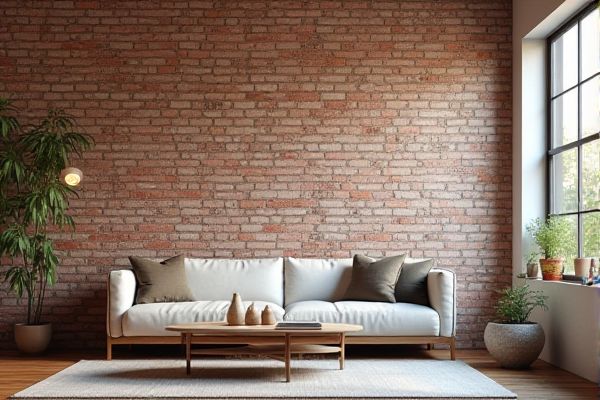
Exposed brick offers a raw, textured aesthetic that showcases the natural character of the material, adding warmth and authenticity to any space, whereas painted brick provides a sleek, uniform finish that can brighten rooms and allow for versatile color choices. Discover how to choose between exposed brick and painted brick to match your style and enhance your home's ambiance in the rest of the article.
Table of Comparison
| Feature | Exposed Brick | Painted Brick |
|---|---|---|
| Appearance | Natural, rustic, textured look | Smooth, uniform color, customizable |
| Maintenance | Minimal, occasional cleaning and sealing | Requires repainting every 5-10 years |
| Durability | Highly durable, resists aging well | Paint may chip or peel, less durable without upkeep |
| Cost | Low to moderate; no paint needed | Moderate; includes paint and labor costs |
| Moisture Resistance | Porous; needs sealing to protect | Paint provides some moisture barrier |
| Style Flexibility | Limited to natural brick tones | Highly flexible; any color or finish |
Introduction to Exposed Brick vs Painted Brick
Exposed brick showcases the natural texture and color variations of original masonry, enhancing the industrial or rustic aesthetic of interior spaces. Painted brick offers a uniform, customizable finish that can brighten rooms and provide a modern, sleek appearance while protecting the surface from moisture and wear. Each choice impacts the room's ambiance, maintenance needs, and long-term durability, making it essential to consider style preferences and functional requirements.
Aesthetic Appeal: Raw Charm vs Modern Elegance
Exposed brick offers raw charm with its natural textures and earthy tones, creating a warm, rustic ambiance that highlights historical character. Painted brick delivers modern elegance through clean, uniform surfaces and versatile color palettes, allowing for sleek, contemporary interior designs. Both options provide distinct aesthetic appeal, with exposed brick emphasizing authenticity and painted brick enhancing sophistication and freshness.
Maintenance and Durability Considerations
Exposed brick offers high durability and requires minimal maintenance, as its natural texture resists wear and hides minor imperfections over time. Painted brick demands regular upkeep due to paint chipping, peeling, and moisture trapping, which can lead to deterioration if not properly managed. Choosing between the two depends on balancing the aesthetic preference for exposed brick's raw look against the periodic maintenance needed for painted surfaces.
Design Versatility and Style Options
Exposed brick offers a raw, industrial charm that enhances rustic, vintage, and modern interior designs with its natural texture and warm tones. Painted brick provides greater design versatility, allowing you to customize color schemes to match any aesthetic, from sleek contemporary to cozy farmhouse styles. Choosing between exposed and painted brick depends on your preference for maintaining authentic character or achieving a polished, seamless look in your space.
Energy Efficiency and Insulation Impact
Exposed brick offers natural thermal mass that can help regulate indoor temperatures by absorbing and slowly releasing heat, improving your home's energy efficiency. Painted brick, while aesthetically versatile, may reduce breathability and trap moisture, potentially impacting insulation performance over time. Choosing exposed brick can enhance natural insulation properties, whereas painted surfaces might require additional measures to maintain optimal energy efficiency.
Cost Analysis: Initial and Long-Term Expenses
Exposed brick often incurs higher initial costs due to the need for thorough cleaning, sealing, and occasional repairs to maintain its natural texture, while painted brick typically requires less upfront investment but demands periodic repainting and maintenance. Long-term expenses for exposed brick are generally lower since it resists wear and can last decades with minimal upkeep, whereas painted brick may require repainting every 5-10 years to prevent peeling and moisture damage. Your choice should weigh these variable costs, considering the aesthetic preference and durability needed for your space.
Environmental and Health Factors
Exposed brick retains its natural, untreated state, minimizing the release of harmful chemicals and promoting better indoor air quality, while painted brick may off-gas volatile organic compounds (VOCs) from paints and primers. The porous surface of exposed brick allows for better moisture regulation, reducing the risk of mold growth that can impact respiratory health. You can enhance your living environment by choosing exposed brick to create a sustainable and healthier home atmosphere.
Resale Value and Market Trends
Exposed brick walls often enhance resale value by appealing to buyers seeking authentic, rustic charm and industrial-style interiors, which remain trendy in urban markets. Painted brick can modernize spaces and attract a broader range of buyers, but improper paint or color choices might decrease appeal and market value. Your choice between exposed and painted brick should balance current market trends and buyer preferences in your local real estate area.
Best Practices for Brick Surface Preparation
Thorough cleaning and removal of dirt, dust, and efflorescence are essential best practices for brick surface preparation when deciding between exposed brick and painted brick finishes. For exposed brick, sealing with a breathable, clear masonry sealer enhances durability while maintaining natural texture, whereas painted brick requires patching cracks and applying a masonry primer to ensure paint adhesion and even coverage. Proper surface preparation prevents moisture penetration, extends the lifespan of the finish, and preserves the aesthetic integrity of both exposed and painted brick surfaces.
Choosing Between Exposed and Painted Brick: Key Takeaways
Exposed brick offers a raw, textured aesthetic that enhances industrial and rustic interiors, while painted brick provides versatility with customizable colors and a smoother finish to suit modern designs. Consider durability and maintenance; exposed brick can be prone to dust and requires sealing, whereas painted brick needs regular touch-ups to prevent peeling. Your choice should align with the desired ambiance, upkeep commitment, and the overall style of your space to achieve the optimal balance between character and functionality.
 homyna.com
homyna.com